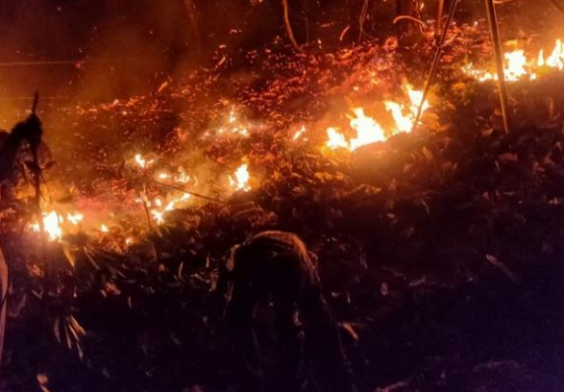
Copyright infringement is not intended
Context: The United Nations has taken note of burning practices and techniques of indigenous peoples around the world as a method to control wildfire incidents in a recent report on increasing incidences of fires globally.
More about news:
- “Support and integrate Indigenous, traditional, and contemporary fire management practices into policy” is one of the recommendations of the United Nations Environment Programme report titled Spreading like wildfire: The rising threat of extraordinary landscape fires.
- Indigenous and traditional knowledge of land management particularly the use of fire to manage fuel, including for wildfire mitigation — can be an effective way of reducing hazard.
- It can ensure that biodiversity and cultural (including understanding traditional gender roles that can govern burning activities) and ecological values are respected, as well as create livelihood opportunities
Examples of Indigenous communities practice that can be globally used to control wildfires:
- Australian Aborigines’ use of fire to create mosaic landscapes for hunting and gathering purposes also broke up the continuity of fuels and so inhibited the extensive spread of wildfires.
- Canadian First Nations used fire as a way of managing their territory.
- Indigenous peoples from the Venezuelan, Brazilian and Guyanese Amazon as well as the Brazilian Cerrado have used fire for subsistence activities and the control of savanna plant fuel levels to prevent the spread of wildfires into adjacent forests.
- Brazil’s Xavante Amerindians, are trained in total fire suppression.
- The Pemón in south-east Venezuela use patch mosaic burning to protect and sustain forests in Canaima National Park, which helps reduce the impacts of wildfires in the region.
- In South America, indigenous knowledge is combined with science to protect indigenous territories from wildfire incidents.
UNEP Fire Ready Formula
The United Nations Environment Programme (UNEP), called on global governments to adopt a new ‘Fire Ready Formula,’ as it warned that incidences of wildfires would rise in the future.
Key highlights of new formula:
- It envisages that 66 per cent of spending be devoted to planning, prevention, preparedness and recovery. The remaining 34 per cent can be spent on response.
- Integrated wildfire managementis key to adapting to current and future changes in global wildfire risk.
- There is a need to invest more in fire risk reduction, work with local communities and strengthen global commitment to fight climate change.
- Achieving and sustaining adaptive land and fire management requires a combination of policies, a legal framework and incentives that encourage appropriate land and fire use.
|
New “Fire Ready Formula” focuses on planning and prevention
|
|
Serial No
|
Budget item
|
Percentage share of the total on wildfire management recommended
|
|
1
|
Planning
|
1 %
|
|
2
|
Prevention
|
32 %
|
|
3
|
Preparedness
|
13 %
|
|
4
|
Response
|
34 %
|
|
5
|
Recovery
|
20 %
|
Source: UNEP report
What was the need for this new formula?
- UNEP report projected that the number of wildfires is likely to increase by up to 14 per cent by 2030. It is projected to spike by 33 per cent by 2050. It would rise by 52 per cent by 2100.
- The prevalence and behaviour of wildfires is changingdue to numerous factors including, but not limited to, climate change.
- Change in land-use and land management practicesare also responsible for the increasing risks of wildfires.
- The true cost of wildfires — financial, social, and environmental— extends for days, weeks, and even years after the flames subside.
What causes the wildfire?
- Natural causes: lightening, soaring temperature, friction between dry leaves, etc. causes forest fires
- Anthropogenic causes:
- Poachers set a small patch of forest on fire to divert the wild animals which many times leads to such fires.
- Jungle areas are also set on fire by villagers to clear the dry leaves on the ground for easy collection of mahua flowers.
- Villagers burn patches of sal trees in the belief that it will lead to better growth when planted again.
How much damage do the forest fires cause?
- Forest fires can cause a lot of damage to the regeneration in the forests and their productivity.
- Moisture-loving trees such as Oaks and Deodars may give way to other species and exotic weeds.
- Forests help maintain aquifers and continuous flow of streams and springs, and provide firewood, fodder and non-timber produce to the local communities – all these capacities may get adversely affected in case of a fire.
- Forest fires may destroy organic matter in the soil and expose the top layer to erosion.
- They may also impact the wildlife by burning eggs, killing young animals and driving the adult animals away from their safe haven.
- Sometimes, a forest fire may get out of control and extend to human settlements, thus posing danger to human life and property.
What can be done to prevent and control forest fires?
- Forecasting fire-prone daysusing meteorological data
- clearing camping sites of dried biomass
- early burning of dry litter on the forest floor
- growing strips of fire-hardy plant species within the forest and
- creating fire lines in the forests are some of the methods to prevent fires.
- fire linesare strips in the forest kept clear of vegetation to prevent the fire from spreading.
- In 1999, the state government notified forest fire ruleswhich restrict or regulate certain activities in and around forest areas such as lighting a fire, burning agricultural stubble or undergrowth (ghasnis) and stacking inflammable forest produce such as dried leaves and firewood.
https://www.downtoearth.org.in/news/environment/un-takes-note-of-global-indigenous-fire-practices-to-control-wildfires-82183




